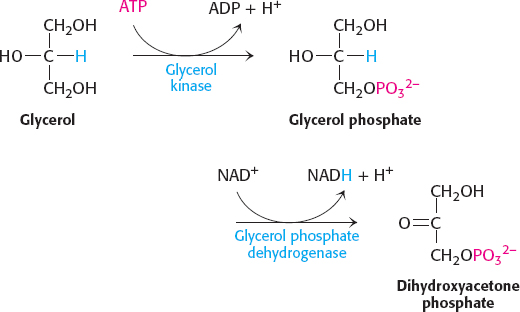Chapter 17
The reverse of glycolysis is highly endergonic under cellular conditions. The expenditure of six NTP molecules in gluconeogenesis renders gluconeogenesis exergonic.
(a) 6; (b) 1; (c) 7; (d) 3; (e) 2; (f) 5 ; (g) 4
In glycolysis, the formation of pyruvate and ATP by pyruvate kinase is irreversible. This step is bypassed by two reactions in gluconeogenesis: (1) the formation of oxaloacetate from pyruvate and CO2 by pyruvate carboxylase and (2) the formation of phosphoenolpyruvate from oxaloacetate and GTP by phosphoenolpyruvate carboxykinase. The formation of fructose 1,6-
bisphosphate by phosphofructokinase is bypassed by fructose 1,6- bisphosphatase in gluconeogenesis, which catalyzes the conversion of fructose 1,6- bisphosphate into fructose 6- phosphate. Finally, the hexokinase- catalyzed formation of glucose 6- phosphate in glycolysis is bypassed by glucose 6- phosphatase, but only in the liver. Reactions in parts b and e would be blocked.
The synthesis of glucose during intense exercise provides a good example of interorgan cooperation in higher organisms. When muscle is actively contracting, lactate is produced from glucose by glycolysis. The lactate is released into the blood and absorbed by the liver, where it is converted by gluconeogenesis into glucose. The newly synthesized glucose is then released and taken up by the muscle for energy generation.
Muscle is likely to produce lactic acid during contraction. Lactic acid is a strong acid and must not accumulate in muscle or blood. Liver removes the lactic acid from the blood and converts it into glucose. The glucose can be released into the blood or stored as glycogen for later use.
Glucose produced by the liver could not be released into the blood. Tissues that rely on glucose as an energy source would not function as well unless glucose was provided in the diet.
Glucose is an important energy source for both tissues and is essentially the only energy source for the brain. Consequently, these tissues should never release glucose. Glucose release is prevented by the absence of glucose 6-
phosphatase. In gluconeogenesis, lactate dehydrogenase synthesizes pyruvate from lactate. In lactic acid fermentation, the enzyme synthesizes lactate from pyruvate.
Complete the interactive matching exercise to see answers.
Some of the amino acids will be released into the blood. The liver will take up the amino acids and convert the carbon skeletons into glucose.
6 NTP (4 ATP and 2 GTP); 2 NADH
(a) None; (b) none; (c) 4 (2 ATP and 2 GTP); (d) none
One cycle would require the glycolytic enzyme phosphofructokinase and the gluconeogenic enzyme fructose 1,6-
bisphosphatase. The other cycle would require pyruvate kinase from glycolysis and pyruvate carboxylase and phosphoenolpyruvate carboxykinase from gluconeogenesis. The substrate cycles regulate flux on one or the other pathway by amplifying metabolic signals.
The enzymes in two substrate cycles are control points. The glycolytic pathway is activated by F-
2,6- BP, AMP, and F- 1,6- BP, whereas ATP, alanine, citrate, and protons inhibit glycolysis. Gluconeogenesis is activated by citrate and acetyl CoA and inhibited by F- 2,6- BP, AMP, and ADP. Complete the interactive matching exercise to see answers.
If the amino groups are removed from alanine and aspartate, the ketoacids pyruvate and oxaloacetate are formed. Both of these molecules are components of the gluconeogenic pathway.
(a) Increased; (b) increased; (c) increased; (d) decreased

Dihydroxyacetone phosphate can be used in gluconeogenesis or glycolysis.
Page C18For glycerol to be fermented to ethanol, two NADH are generated. However, only one of NAD+ is regenerated during alcoholic fermentation. Thus, redox balance is not maintained and the yeast run out of NAD+ and pass on.
If both enzymes operated simultaneously, the following reactions would take place:

The net result would simply be
ATP + H2O → ADP + Pi
The energy of ATP hydrolysis would be released as heat.
Not really. For the cycle to generate heat, both enzymes must be functional at the same time in the same cell.
The species B. terrestris and B. rufocinctus might show some futile cycling because both enzymes are active to a substantial degree.
No. These results simply suggest that simultaneous activity of phosphofructokinase and fructose 1,6-
bisphosphatase is unlikely to be employed to generate heat in the species shown.
Lactic acid is capable of being further oxidized and is thus useful energy. The conversion of this acid into glucose saves the carbon atoms for future combustion.
Fructose 2,6-
bisphosphate, present at high concentration when glucose is abundant, normally inhibits gluconeogenesis by blocking fructose 1,6- bisphosphatase. In this genetic disorder, the phosphatase is active irrespective of the glucose level. Hence, substrate cycling is increased. The level of fructose 1,6- bisphosphate is consequently lower than normal. Less pyruvate is formed and thus less ATP is generated. There will be no labeled carbon atoms. The CO2 added to pyruvate (formed from the lactate) to form oxaloacetate is lost with the conversion of oxaloacetate into phosphoenolpyruvate.
The input of four additional high-
phosphoryl- transfer- potential molecules in gluconeogenesis changes the equilibrium constant by a factor of 1032, which makes the conversion of pyruvate into glucose thermodynamically feasible. Without this energetic input, gluconeogenesis would not take place.